Commitments to the Circular Economy
Raw Material Procurement
The Ryohin Keikaku Group relies heavily on natural resources for many of the raw materials used in its products. Unsustainable use of natural resources, deforestation, and land conversion contribute to biodiversity loss and climate change. In addition, global demand for natural resources is increasing, affecting not only ecosystems but also people's lives and health.
As a company that uses a wide range of natural resources from around the world, we recognize that sourcing sustainable raw materials is both a critical challenge and a responsibility. Accordingly, we are committed to responsible sourcing practices that respect human rights and minimize negative impacts on the environment and animals.
Raw Material Procurement for Textile and Leather Products
The Ryohin Keikaku Group actively selects what we define as "environmentally responsible materials" -- materials with ethical considerations for the global environment, animal welfare, producers, and local communities -- and aims to achieve 100% procurement of such materials by FY2030. "Environmentally responsible materials" are those evaluated and approved by the Ryohin Keikaku Group as being in line with our policies on human rights, the environment, and animal welfare.
Plant-based Fibers
Cotton

The Ryohin Keikaku Group has used organic cotton since 1999. From 2023, we have set a goal of "source 100% of socially and environmentally responsible cotton" and are striving for a stable sourcing of sustainable cotton by adding more options, not limited to organic cotton. Cotton that Ryohin Keikaku evaluated as socially and environmentally responsible includes organic cotton*1, sustainably grown cotton*2, and recycled cotton*3.
Cotton is one of the few plants that can be harvested in arid zone and desert climate which is unsuitable for agriculture. Organic cotton is cotton that is grown in accordance with the standards of organic farming methods in each country, without using pesticides that may have a significant impact on the environment and living organisms, and in soil that has passed a certain period of time during which the residual components of pesticides are expected to decrease.
Recycled cotton is made from fabric scraps generated during the clothing production process and fabric products which do not meet the standards. After being sorted and grinded, they are broken down into cotton fibers, and regenerated as materials by being blended with virgin cotton. The natural appearance is its characteristic.
*1 Cotton certified under Regenerative Organic Certified (ROC), Global Organic Textile Standard (GOTS), Organic Content Standard (OCS) or an equivalent certification.
*2 Cotton certified under Cotton made in Africa (CmiA), which aims to improve the living and working conditions of smallholder farmers and protect the natural environment in production regions, or an equivalent certification.
*3 Cotton certified under either the Global Recycled Standard (GRS), the Recycled Claim Standard (RCS), or an equivalent certification.
Linen

Linen is made from flax, a plant with low environmental impact in terms that it can be cultivated with small amounts of pesticides, fertilizers, and water. In addition to its fibers, the entire flax plant can be used effectively without waste, from its seeds as linseed oil to its stems and roots as building and agricultural materials. Other benefits include its rapid growth and efficient absorption of CO2.
Hemp
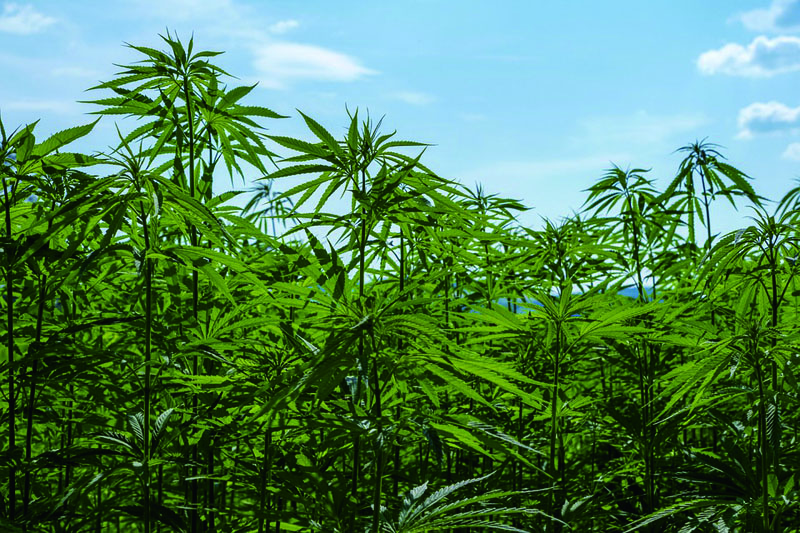
Hemp is said to be the world's oldest cultivated crop, and its fibers have been used in Japan since ancient times for clothes, religious ropes, and straps for sandals. Its seeds are said to be the easiest protein to digest and have been used for food and cosmetic oil. Hemp stems are used for construction materials and automobile interior parts.
In addition, hemp is a plant that grows tall rapidly, nearly 3 meters in 3 months, and therefore absorbs CO2 efficiently. It can also be cultivated using very little fertilizer and water and requires almost no pesticides due to its resistance to pests and diseases. Therefore, it can be considered as a material with low environmental impact.
As a fabric, it absorbs and releases moisture well, is breathable and dries quickly, and is also very durable. It is also highly regarded for its natural antibacterial properties and UV blocking effect. The appearance is refreshing, and the texture softens as being worn.
Jute

Jute has long been used for grain sacks, rugs and other items that make use of its high durability. Cultivated mainly in hot, humid wetlands in the tropics and subtropics that are unsuitable for agriculture, jute grows rapidly and absorbs CO2 efficiently. It can also be considered as having a low environmental impact since it can be cultivated using very little fertilizer and water and requires almost no pesticides due to its resistance to pests and diseases.
Kapok
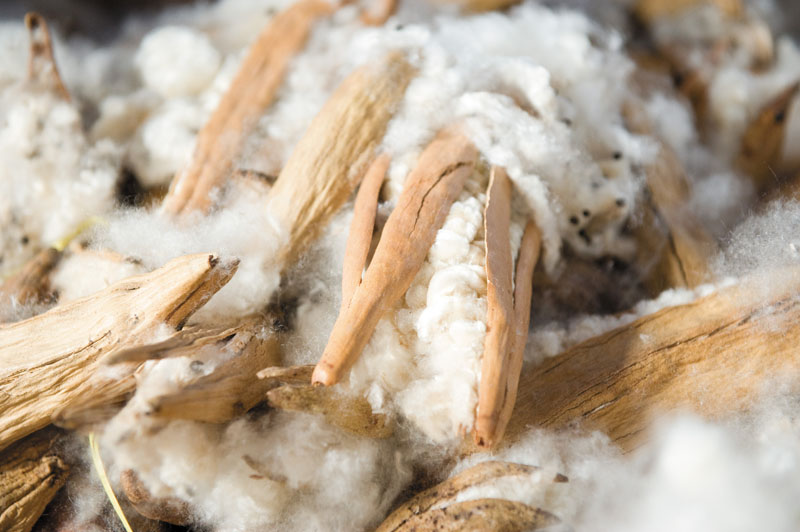
Kapok is a plant-based fiber derived from the seed pods of the kapok tree. Before petroleum-based synthetic fibers such as polyester became widely used, kapok was commonly utilized as filling material for items like pillows, stuffed toys, and life jackets. Its main production regions include Indonesia, Thailand, and India. Kapok trees require minimal pesticides, fertilizers, or irrigation, and as they grow into large trees over a lifespan of more than 70 years, they continue to absorb significant amounts of CO₂. Since harvesting the seed pods does not require cutting down the tree, kapok is gaining attention as a material with exceptionally low environmental impact.
One of kapok's most distinctive features is its lightness and the natural functionality it offers. The hollow structure at the center of each fiber allows it to trap air, making kapok the lightest natural fiber in the world--approximately one-eighth the weight of cotton. Kapok also helps regulate comfort by absorbing moisture to retain warmth in cold conditions and releasing moisture to stay cool in hot weather. Thanks to recent technological advancements, kapok can now be spun into yarn. By promoting product development that utilizes kapok, we aim to contribute to the economic development of production regions through the effective use of unused resources.
Animal-based Fibers and Materials
Feather and Down
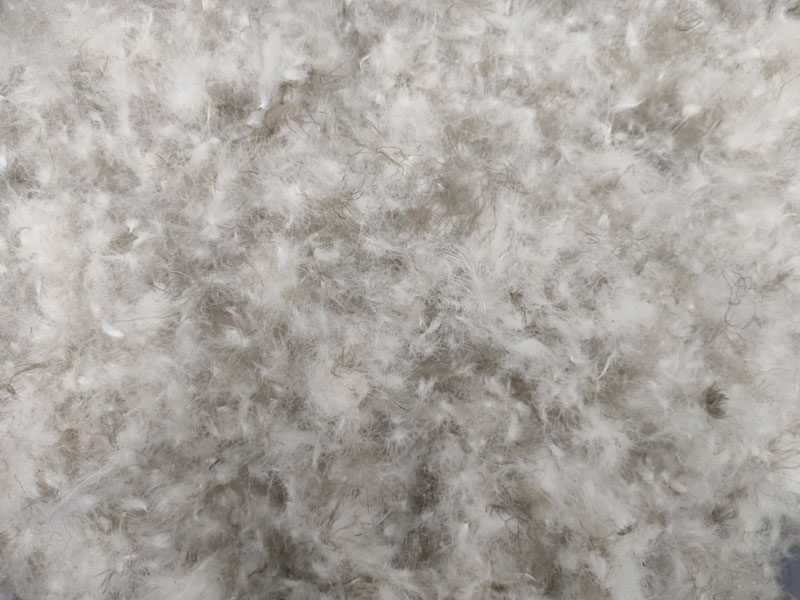
The Ryohin Keikaku Group sources feathers that have been rigorously screened and certified*1 by third-party entities to ensure that the "Five Freedoms of Animal Welfare*2" are respected in the breeding environment, and that the birds have not been force-fed or live plucked. In selecting materials, we consider not just their functionality, but also the people who use them, the people who make them and the approaches of interacting with nature.
*1 Down certified under the Responsible Down Standard (RDS) or an equivalent animal welfare certification.
*2 The five freedoms of animal welfare are as follows: (1) freedom from hunger and thirst; (2) freedom from fear and distress; (3) freedom from discomfort; (4) freedom from pain, injury, or disease; and (5) freedom to express normal behavior (source: Ministry of Agriculture, Forestry and Fisheries, "Livestock breeding management with consideration of animal welfare")
Wool

The Ryohin Keikaku Group sources wool for apparel and household goods from farms that practice animal welfare, as well as recycled wool.
There are various methods of raising sheep according to regional difference, but we source only non-mulesed wool* for our products. Non-mulesed wool refers to wool from sheep that have not undergone mulesing, which is a special technique involving the removal of skin and flesh to prevent maggot infestation. This method is commonly used for sheep raised in particularly hot climates. When sourcing wool, we ensure that it comes from farms that do not practice mulesing.
Recycled wool is made by shredding wool products that have been discarded or collected, and then spinning the material back into yarn. It is an important material from the perspective of waste management and resource recycling. Recycled wool is characterized by its deep hue, created by the blending of multiple colors, and its rustic texture.
*Excluding recycled wool.
Regenerated Cellulose Fibers
Lyocell

Lyocell is a regenerated cellulose fiber primarily made from wood. The Ryohin Keikaku Group aims to continue sourcing all lyocell used in its products from suppliers that use wood proven to be free from deforestation and forest degradation, and that actively work to reduce environmental impact through proper management of chemicals and wastewater during the manufacturing process.
Rayon
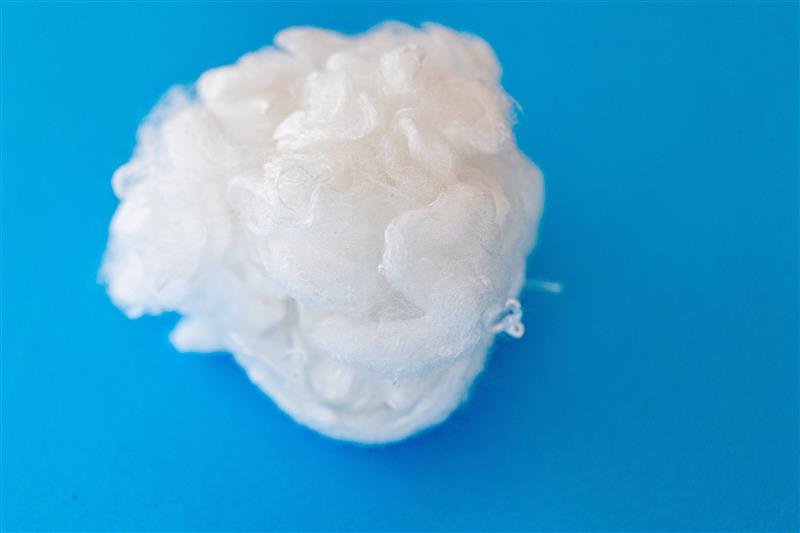
Rayon is a regenerated cellulose fiber primarily made from wood. The Ryohin Keikaku Group aims to source all rayon used in its products by FY2030 from suppliers that use wood proven to be free from deforestation and forest degradation, and that actively work to reduce environmental impact through proper management of chemicals and wastewater during the manufacturing process.
Synthetic Fibers
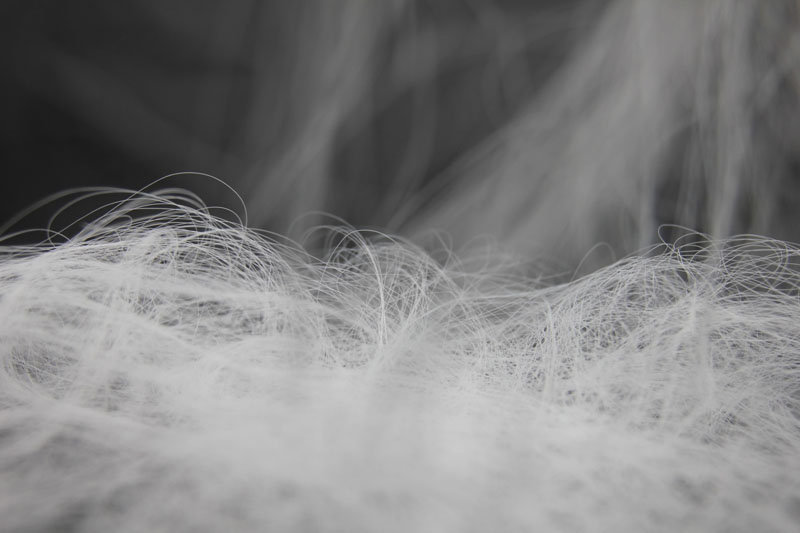
The Ryohin Keikaku Group envisions a future in which all synthetic fibers used in its products are derived from recycled or plant-based raw materials. To move toward this vision, we aim to ensure that by FY2030, all products using synthetic fibers incorporate materials made from recycled or plant-based raw materials.
Recycled materials refer to certified* fibers such as recycled polyester and recycled nylon, which help reduce the use of fossil-based raw materials and contribute to lowering environmental impact.
Recycled polyester is mainly made from materials derived from PET bottles, while recycled nylon is made from pre-consumer recycled materials, such as discarded fibers from the yarn production process.
We are also working to expand the use of plant-based raw materials in synthetic fibers and to develop biodegradable alternatives.
*Certified under the Global Recycled Standard (GRS), the Recycled Claim Standard (RCS), or an equivalent certification.
Other Initiatives Related to Textile Materials
Leftover Yarn and Cloth
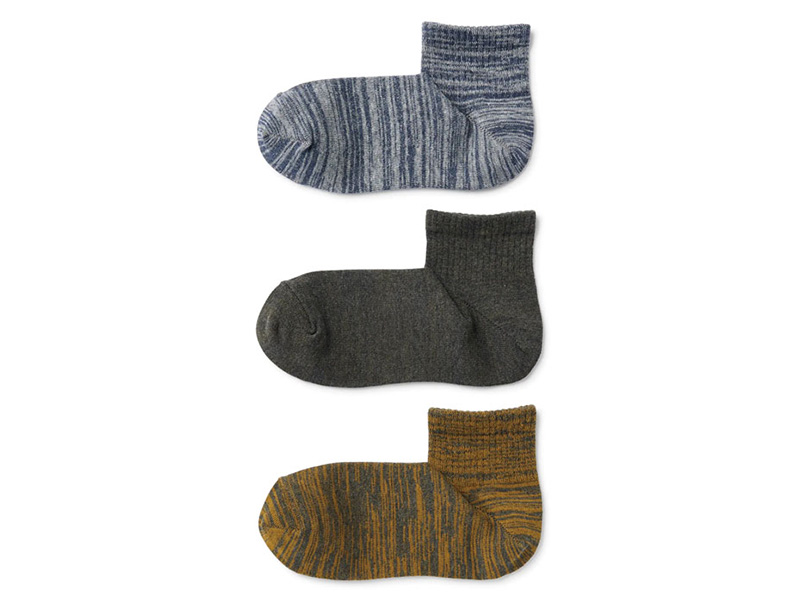
MUJI's longstanding approach of eliminating wastefulness informs its selection of materials. In 2000, we started sales of socks made from excess yarn that had been leftover at the factory and discarded.
By using leftover yarn and cloth which come from the manufacturing process of our production partners, we constantly work to reduce waste, which is a major issue in the apparel supply chain.
Timber
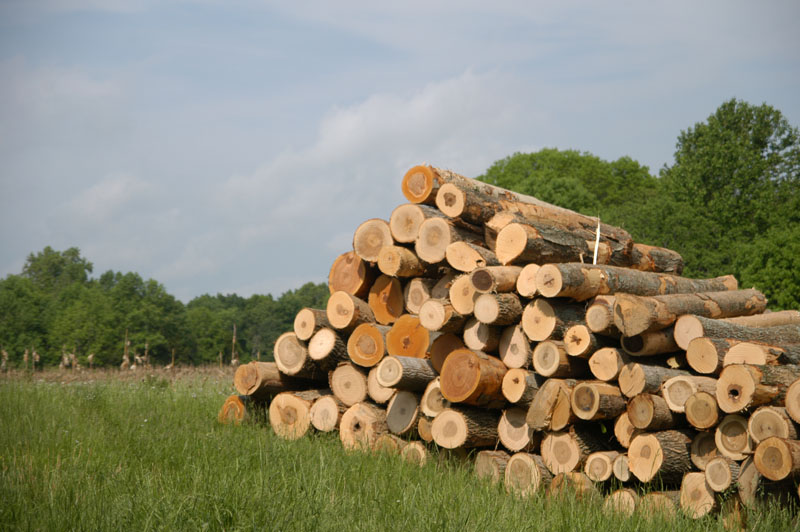
We adhere to the Clean Wood Act and relevant environmental regulations in all countries and regions where we operate to ensure legal logging for our wooden and paper products*. We also conduct self-assessments for wood material due diligence and collect certificates such as FSC and PEFC and other official documents from the public sector, as well as purchase and transportation records, to prevent the use of illegally logged wood.
*Excluding 100% recycled paper and cardboard products.
Development and Sales of Office Furniture Using Native Japanese Cedar
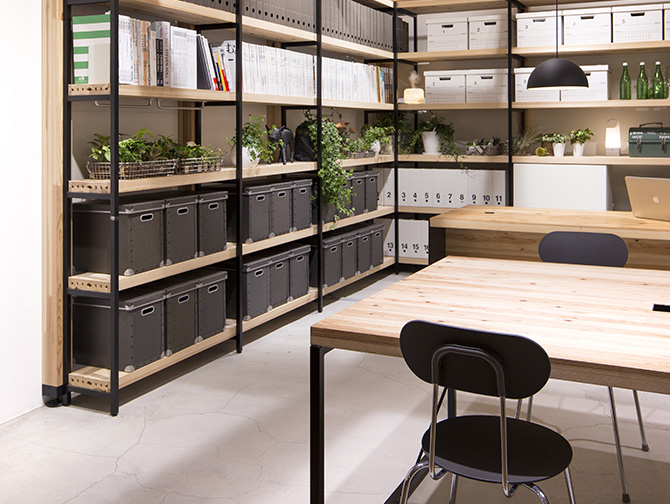
Japan is the third-largest forest country in the world, with forests accounting for 67% of the national land area.
By contrast, only approximately 30% of the total timber consumed in Japan comes from domestic sources.
The devastation of poorly managed forests has become a major social problem.
To preserve the environment of Japanese forests while stimulating the forestry industry, MUJI developed office furniture made of native Japanese cedar in collaboration with Uchida Yoko Co., Ltd., a pioneer in the development of office supplies using domestic timber, with the aim of creating pleasant workplaces.
Cedar timber is generally used as a building material, and the remainder is mainly recycled into disposable chopsticks and fuel.
By working with a manufacturer in Miyazaki Prefecture, who has developed a technology to process such remaining cedar into a panel that can be used as furniture, we succeeded in incorporating the remainder into the furniture production line.
Cedar is used for the desktop and shelf boards which users touch with their own hands, and steel is used for the structural part to ensure strength.
By effectively using the whole tree in our products, we have expanded the usage of domestic cedar.
Selection of Ingredients for Café&Meal MUJI
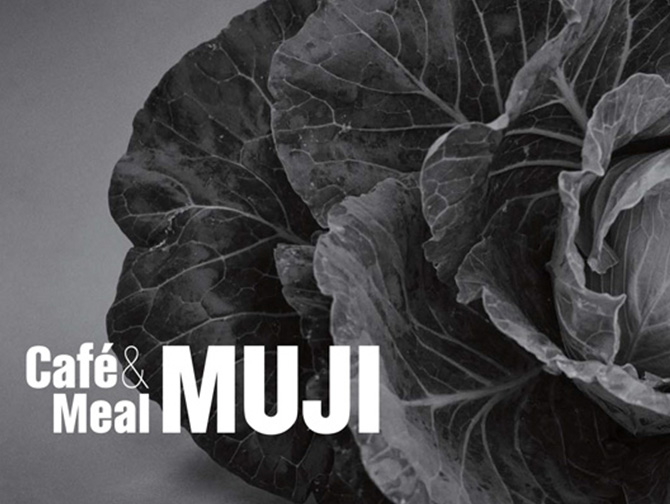
At Café&Meal MUJI, we offer a variety of dishes based on the theme of Simple Food is Delicious, which make the most of the inherent qualities of ingredients and are easy on the body and delicious to eat, along with seasonal ingredients filled with blessings of nature. We especially recommend the delicatessen menu, which features nutritionally balanced, healthy meals made using plenty of seasonal vegetables.
As for the ingredients that support the menu, our staff in charge travel around the world and directly visit production areas to source such seasonal ingredients while interacting with the producers. Furthermore, we actively use ingredients grown by eco-friendly farming methods. Allergic ingredients are displayed on the Café&Meal MUJI menu.
